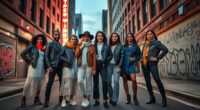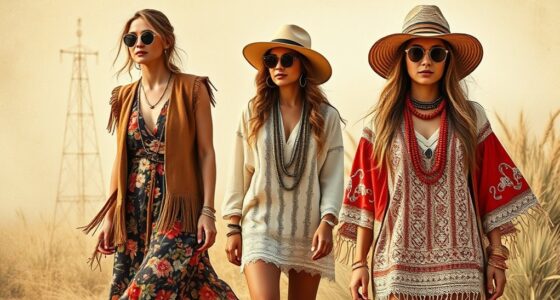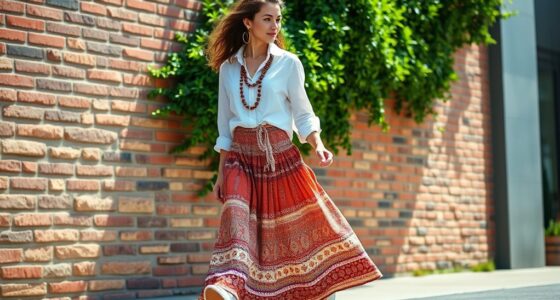Boho fashion draws its vibrant style from diverse cultural influences like tribal motifs, folk embroidery, and traditional craftsmanship worldwide. You’ll notice patterns and details that pay homage to indigenous stories, beliefs, and histories, adding authenticity and depth to your look. These elements celebrate artistry from different regions, promoting cultural appreciation and unity. Each piece reflects a blend of tradition and modernity, inviting you to explore how global storytelling shapes boho style—if you want to discover more, keep exploring.
Key Takeaways
- Tribal motifs in boho fashion symbolize indigenous stories, beliefs, and cultural identities from around the world.
- Folk embroidery reflects regional traditions, adding handcrafted texture and showcasing age-old techniques.
- Embroidered details often carry cultural significance, celebrating festivals, prosperity, and community heritage.
- Boho fashion promotes cultural appreciation and unity by honoring diverse artistic expressions and craftsmanship.
- Incorporating traditional patterns and embroidery transforms boho style into a dialogue that celebrates global cultural richness.

Boho fashion, known for its free-spirited and eclectic style, draws heavily from a rich tapestry of cultural influences around the world. You’ll notice that tribal motifs are a common element, often incorporated into patterns that echo traditional artwork and symbolism from various indigenous communities. These motifs aren’t just decorative; they carry cultural significance, representing stories, beliefs, and identities. When you wear a garment featuring tribal motifs, you’re not just making a fashion statement—you’re paying homage to a heritage rooted in history and spirituality. Similarly, folk embroidery plays a crucial role in creating that handcrafted, artisanal feel characteristic of boho style. This intricate needlework, often done by skilled artisans, reflects regional traditions and techniques passed down through generations. Whether it’s colorful floral motifs from Eastern Europe or geometric designs from Central Asia, folk embroidery adds texture and depth to your outfit, making each piece uniquely cultural. The use of traditional craftsmanship in boho fashion emphasizes the importance of preserving these age-old techniques for future generations.
You might find yourself drawn to embroidered belts, bags, or jackets decorated with these traditional stitches, which instantly elevate your look with their authenticity. These details are more than aesthetics—they connect you to a broader cultural narrative. For example, Mexican embroidery often features vivid floral patterns that celebrate vibrant local festivals, while Indian embroidery incorporates detailed mirror work that signifies celebration and prosperity. By choosing garments with folk embroidery, you actively participate in preserving and honoring these traditional crafts, supporting artisans and their communities.
Boho fashion’s embrace of tribal motifs and folk embroidery also promotes a sense of global unity and appreciation for diversity. When you wear a piece inspired by a specific culture, you’re acknowledging its artistic heritage and storytelling power. This approach encourages curiosity about different customs and histories, making your style a form of cultural dialogue. It’s important, though, to approach these influences with respect and awareness. Opt for authentic, ethically sourced items or handcrafted pieces that honor the original artisans’ skills and traditions. This way, your fashion choices become a meaningful expression of cultural appreciation rather than mere trend-following.
Ultimately, tribal motifs and folk embroidery make boho fashion more than just a look—they transform it into a celebration of cultural richness. As you wear these elements, you carry a piece of history and identity with you, blending tradition with modern style. This fusion reminds you that fashion can be a powerful way to honor and connect with diverse cultural stories, making your boho wardrobe a vibrant mosaic of global artistry.
Frequently Asked Questions
How Did Boho Fashion Originate Historically?
You might wonder how boho fashion started. It originated during the hippie movement of the 1960s, embracing free-spirited and unconventional styles. This look draws inspiration from indigenous textiles, combining ethnic patterns and handcrafted details. You see, it’s a blend of bohemian ideals and cultural influences, creating a relaxed, artistic vibe that celebrates diversity and individual expression. This fusion makes boho fashion a timeless reflection of cultural appreciation and personal freedom.
Which Specific Cultures Influence Boho Style the Most?
Imagine you’re browsing boho styles, and you notice Native American motifs and Middle Eastern textiles. These elements influence boho fashion the most, reflecting a blend of diverse cultural roots. Native American patterns add earthy, spiritual symbolism, while Middle Eastern fabrics introduce intricate, vibrant designs. Together, they create a unique, eclectic aesthetic that celebrates global artistry, making boho style a beautiful tapestry of cultural exchange and creativity.
Are There Ethical Concerns With Boho Fashion’s Cultural Elements?
You might wonder if boho fashion raises ethical concerns, especially around cultural appropriation. It’s important to contemplate how designers and consumers handle cultural elements—are they respecting traditions or just borrowing without understanding? Ethical sourcing also matters, ensuring that materials and craftsmanship support original communities. By being mindful of these issues, you can enjoy boho style while respecting its cultural roots and promoting fair practices.
How Can I Incorporate Boho Influences Respectfully?
You’re right to want to walk the line between style and respect. To incorporate boho influences respectfully, focus on cultural appreciation rather than appropriation. Educate yourself about the origins of the elements you love, and choose authentic pieces that honor their meaning. This approach helps maintain fashion authenticity while showing genuine respect. Remember, it’s always better to tip the scales toward respect than to stumble over cultural insensitivity.
What Are the Key Symbols Used in Boho Fashion?
In boho fashion, you’ll notice key symbols like feathers, mandalas, and floral motifs, which carry deep meanings. These symbolic motifs are often paired with earthy color palettes—warm tones, muted shades, and vibrant accents—that reflect a free-spirited vibe. You can incorporate these symbols and colors into your wardrobe through accessories, prints, or layered outfits, creating a look that’s both stylish and meaningful.
Conclusion
As you embrace boho fashion, you’re celebrating a rich tapestry of cultures and histories. Each piece tells a story, connecting you to distant lands and ancient traditions. Isn’t it amazing how style can be a bridge to understanding and appreciation? By choosing boho, you’re not just making a fashion statement—you’re honoring diverse cultural expressions. So, why not continue exploring and weaving these inspirations into your unique style journey?










